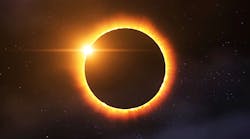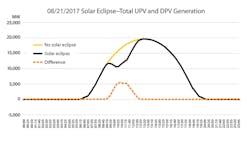During last summer’s total eclipse, solar energy output in the West dropped by about 5.9 gigawatts (GW), according to recent analysis from the Department of Energy’s National Renewable Energy Laboratory. The eclipse cast a shadow from Oregon to South Carolina, completely concealing the sun along a 70-mile-wide path and causing the rest of the continent to experience partial darkness. The event provided the opportunity for researchers to see the effects of an eclipse on the U.S. electrical grid, which has had a steady increase in power from photovoltaic (PV) plants.
“The study helped develop the framework and the tools for understanding the effect of a wide-area phenomena, such as a storm or another eclipse on PV output and grid reliability,” says Santosh Veda, a research engineer at NREL and co-author of the report. “These tools will become increasingly important as the PV penetration continues to grow so we can reduce any harmful effects of these events on the grid.”
To determine the eclipse’s effect, researchers analyzed real-time data—including load and electricity generation—from Western Interconnection, the electric grid connecting utilities in nine entire western U.S. states, parts of five more, the two westernmost provinces of Canada, and a small section of northern Mexico. Data was gathered from Western Interconnection reliability coordinator Peak Reliability in one-minute intervals for three days in August before and after the eclipse, and in 10-sec. increments during the eclipse, to establish a credible baseline.
Researchers also used data from the first six months of the year to determine how eclipses differ from other major weather events. Although the overall PV output varies from one day to the next, the rate at which it rose and fell during the eclipse was markedly different.
In addition, researchers compared how much utility-scale PV and rooftop solar set-ups generate on a typical day to the output during the eclipse.
Across the region studied, utility-scale solar plants, not including concentrated solar power plants, have the capacity to generate 15.8 GW of electricity; rooftop solar can provide an additional 9.2 GW. On a typical day, utility-scale facilities generate more than 12 GW. During the eclipse, however, the panels lost an estimated 4 GW of production. Rooftop solar, which typically produces about 8 GW, lost 1.9 GW during the eclipse.
Despite the temporary drop in solar power, the stability and reliability of the grid was unaffected. Electricity generated by hydroelectric, natural gas, and coal plants easily met the difference in energy demand. The NREL study, which also considered production costs involved when PV isn’t available, found the increase in costs of complimentary energy sources to be minimal.


